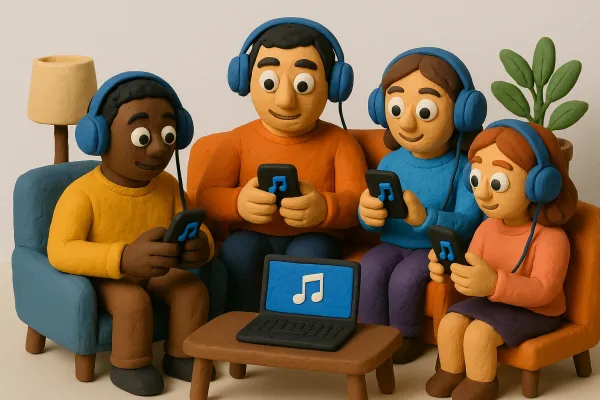The Ultimate Guide to Sending Your Music to Radio Stations: Tips and Strategies for Success

So, you're ready to get your music on the radio? That's awesome! But it's not just about sending your tracks out and hoping for the best. It's a bit more strategic than that. You need to pick the right song, find the right stations, and make sure your submission stands out. Plus, building relationships with radio contacts and creating a buzz around your music are key steps. Let's break it down so you can get your tunes heard by more people.
Key Takeaways
- Choose a song that's catchy and fits radio formats; not every great track is radio material.
- Research stations that match your style and audience; targeting the right ones increases your chances.
- Follow submission guidelines closely; every station has its own preferences.
- Build relationships with DJs and music directors; networking can open doors.
- Track your success and adapt; use analytics to see what's working and what isn't.
Picking the Perfect Track for Radio
Why Your Best Song Might Not Be Radio-Friendly
Alright, let's talk about the elephant in the room. Your favorite track might not be the best for radio. Shocking, right? But here's the deal: radio stations have a specific taste. They love catchy hooks, upbeat tempos, and tracks that don't drag on forever. If your masterpiece is a seven-minute ballad, it might be time to rethink. Consider the song's length and lyrics. Does it have explicit content? If so, you might need to make a radio edit to comply with FCC regulations.
The Importance of High Audio Quality
Now, imagine your song playing through a car stereo. Does it sound crisp and professional? If not, it's back to the studio. High audio quality is non-negotiable. We're talking about well-mixed, well-mastered tracks. And hey, don't forget to have both MP3 and WAV versions ready. Some stations prefer one over the other, so it's good to cover all bases.
Creating a Radio Edit
So, you've got the perfect track, but it's a tad too long or has a few choice words. Time for a radio edit! This isn't just about chopping bits off. It's about keeping the essence while making it radio-friendly. Trim down the intro, tighten the chorus, and make sure it fits within that sweet 3-4 minute range. It's a bit of a puzzle, but totally worth it to get your music out there.
Picking the right track for radio is like choosing an outfit for a first date. You want to impress, show off your style, but also fit the occasion. It's all about balance and making sure you're putting your best foot forward.
Researching the Right Radio Stations

Understanding Your Target Audience
When we talk about sending our music to radio stations, the first thing to nail down is understanding who our audience is. It's not just about who listens to our music, but also who we want to reach. Are we aiming for teenagers, young adults, or maybe a more mature crowd? Knowing this helps us pinpoint which stations are worth our time. Spend some time listening to different stations or checking out their social media to get a feel for their vibe and audience. Local and community stations, especially in the U.S., can be a goldmine for new artists.
Finding Local and Genre-Specific Stations
Once we know our audience, it's time to find the stations that match. This is where some good old-fashioned research comes in. Google is our friend here. Search for local stations in our area or even genre-specific ones that fit our style. For example, typing "Irish radio stations" or "hard rock radio stations" can give us a list to start with. Don't forget to check out where similar bands or artists are getting airplay. It can give us a clue about which stations might be open to our music.
Utilizing Online Tools for Station Research
In today’s digital age, there are plenty of online tools that can help us in our station hunt. Websites like this article offer insights into various submission methods and can be a great starting point. These platforms can streamline our research process, providing lists of stations by genre or location, and sometimes even contact details. It's all about making the most of the resources available to us.
Crafting the Perfect Submission

Following Submission Guidelines
Alright, folks, let's get real about submission guidelines. They're not just suggestions; they're the rulebook. Ignoring them is like trying to play soccer without knowing the offside rule—you're gonna get flagged. Every station has its own set of rules, so read them thoroughly. From file formats to submission deadlines, knowing these details can make or break your submission. When you follow the guidelines, you’re showing respect for the station's process and making it easier for them to consider your music.
Building a Strong EPK or Press Release
Your Electronic Press Kit (EPK) is basically your music resume. It should be as polished as your tracks. Include a short artist bio, some high-quality photos, and links to your social media. Don’t forget the music! Whether it's MP3s or streaming links, make sure they’re easy to access. Contact info is crucial—how else will they let you know they love your stuff? A strong EPK makes you look professional and ready for the big time.
Personalizing Your Pitch
Now, let’s talk pitches. A generic pitch is like spam, and nobody likes spam. Personalizing your pitch can set you apart. Start with a personalized introduction addressing the DJ or music director, explaining why your music suits their station. Mention something specific about the station or the DJ to show you’ve done your homework. This isn’t just about flattery; it’s about making a real connection. Keep it short, engaging, and to the point. Remember, you’re not just selling a song; you’re introducing them to you as an artist.
Crafting the perfect submission is like baking the perfect cake. You need the right ingredients in the right amounts, and a little bit of love doesn’t hurt either. Get it right, and you’ll have something truly irresistible.
Building Relationships with Radio Contacts
Reaching Out to DJs and Music Directors
Alright, so you’ve got your music ready, now it's time to make friends with the folks who can get it on air. First off, personalize every email. DJs and music directors get tons of pitches every day, so a little personal touch goes a long way. Use their name, mention their show, and say why your track would be a good fit. It's like dating; nobody likes a generic opening line.
Here's a quick list to keep in mind:
- Research: Know the station's vibe and the kind of music they play.
- Be Brief: Keep your email short but engaging.
- Follow Up: If you don’t hear back, it’s okay to send a friendly nudge after a week or so.
Networking Through Social Media
Social media isn’t just for selfies and memes; it’s a powerful tool for promoting your music and connecting with radio folks. Follow stations, DJs, and music directors on platforms like Twitter and Instagram. Engage with their posts genuinely—comment, like, and share content that resonates with you. Over time, they’ll start recognizing your name, and that’s when the magic happens.
Here's a little tip: Don’t bombard them with messages about your music. Instead, let them come to you by being active and supportive in their online community.
The Power of Local and College Stations
Never underestimate the influence of local and college radio stations. They may not have the reach of big networks, but they’re often more open to new artists and are a great way to build a following. Local stations are all about community, so if you’re playing a gig nearby, let them know! It’s a win-win; they get to promote local events, and you get airplay.
College stations, especially, are goldmines for independent artists. They love fresh talent and aren’t as tied to commercial playlists, meaning you’ve got a better shot at getting your music heard.
Building genuine relationships with radio contacts isn’t just about getting your song played. It's about creating a network that supports you throughout your career. So, keep it real, be patient, and remember that every connection is a step towards something bigger.
Creating Buzz Around Your Music
Engaging with Your Audience on Social Media
Alright, let's talk social media. It's not just about posting your latest single and hoping it blows up. We need to connect with our fans in a real way. Think about sharing behind-the-scenes clips, asking for feedback on new tunes, or even just chatting about your favorite artists. It's all about building a community where people feel part of your journey.
- Post regularly but keep it genuine.
- Use stories or live streams for real-time interaction.
- Encourage fans to share their stories related to your music.
"Social media isn't just a tool for promotion; it's a space where we can truly engage with our audience, making them feel like they're part of our musical journey."
Performing Live to Build a Following
There's nothing quite like the energy of a live show. Whether it's a local gig or a virtual concert, performing live is a killer way to build a following. Plus, it's fun! When we hit the stage, we get to show our music in its rawest form, and fans dig that.
- Start with local venues or open mics.
- Consider live streaming your performances for wider reach.
- Interact with the audience during and after the show.
Leveraging Streaming Platforms for Exposure
Streaming platforms are where it's at these days. They're not just for listening but for discovering new music too. We need to make sure our music is optimized for platforms like Spotify and Apple Music. This means having a complete profile, engaging album art, and making use of playlists.
- Ensure your artist profile is up-to-date.
- Submit your tracks to curated playlists.
- Encourage fans to save and share your music.
And hey, don't forget about a PR campaign. It's a fantastic way to generate excitement for your new releases and get your music in front of more ears. Let's make some noise and get our music heard!
Tracking Your Radio Success
Alright, so you've got your music on the radio. That's awesome! But what's next? Well, we gotta make sure it's not just playing in the background somewhere, but actually making waves. Here's how we do it:
Using Analytics to Monitor Airplay
First off, let's talk about keeping tabs on where and how often your songs are playing. Tools like Nielsen BDS or Spinitron are great for this kind of tracking. They help us see which stations are spinning our tracks and how often. It's like having a radar for your music! And don't forget to chat with DJs to get some listener feedback too.
Understanding Key Airplay Metrics
Now, onto the numbers. What should we be looking at? Spins, for starters. That's how many times your song gets played. But also, check out which stations are playing your tracks the most, and in which cities or countries. This info is gold for planning your next moves. Knowing where your music is hot can help you target those areas better.
Adapting Your Strategy Based on Data
Finally, let's use all that data to tweak our game plan. If you see your song is getting a lot of love in a particular area, maybe it's time to focus your promotional efforts there. Or, if one track is performing better than others, consider pushing it more. It's all about being flexible and smart with the info you've got.
Tracking your radio success isn't just about counting spins. It's about understanding the story those numbers tell and using that story to keep the momentum going. Remember, every play is a chance to reach new ears and grow your fanbase.
To see how well your radio station is doing, it's important to keep track of your progress. Check out our website for tips and tools that can help you measure your success. Don't miss out on the chance to improve your station!
Wrapping It Up
Alright, so there you have it! Sending your music to radio stations might seem like a big task, but with the right approach, it’s totally doable. Remember, it’s all about picking the right track, knowing your audience, and making sure your music sounds top-notch. Don’t forget to do your homework on the stations and follow their submission rules. And hey, a little networking never hurts, right? Whether you’re just starting out or you’ve been in the game for a while, getting your music on the radio can be a game-changer. So, get out there, give it your best shot, and who knows? You might just hear your song on the airwaves soon. Good luck!
Frequently Asked Questions
How do I pick the right song for radio?
Choose a song that shows off your style but is also catchy and not too long. Make sure it sounds great and isn't explicit.
What's the best way to find radio stations to send my music to?
Look for stations that play your kind of music. Check out local stations and use online tools to find ones that fit your style.
How can I make my music submission stand out?
Follow the station's rules for submissions, have a strong press kit, and personalize your message to them.
Why is it important to connect with radio contacts?
Building relationships with DJs and music directors can help get your music played. You can reach out through social media or meet them at events.
How do I create buzz around my music?
Engage with fans on social media, play live shows, and use streaming platforms to get more exposure.
How can I track my success on the radio?
Use analytics tools to see how often your music is played and understand what works so you can improve your strategy.





